The antibiotic susceptibility testing devices market is expected to grow from USD 361.1 million in 2025 to USD 599.5 million by 2035, driven by rising antimicrobial resistance surveillance requirements and expanding diagnostic testing capacity across healthcare systems. In the first half of the forecast period, the market increases to approximately USD 465.3 million by 2030, adding USD 104.2 million and accounting for 44 percent of total decade growth. This stage is defined by rapid adoption of automated susceptibility testing platforms, which reduce manual interpretation errors, shorten turnaround times, and support standardized reporting across laboratories. Acute care hospitals, infectious disease departments, and centralized reference labs are prioritizing systems capable of handling high sample throughput efficiently, particularly as resistant infections become more common in both inpatient and outpatient settings.
The first half of the decade (2025-2030) will witness the market climbing from USD 361.1 million to approximately USD 465.3 million, adding USD 104.2 million in value, which constitutes 44% of the total forecast growth period. This phase will be characterized by the rapid adoption of automated susceptibility testing systems, driven by increasing antimicrobial resistance monitoring requirements and the growing need for advanced precision testing solutions worldwide. Enhanced diagnostic capabilities and automated quality control systems will become standard expectations rather than premium options. The latter half (2030-2035) will witness continued growth from USD 465.3 million to USD 599.5 million, representing an addition of USD 134.2 million or 56% of the decade's expansion. This period will be defined by mass market penetration of rapid identification technologies, integration with comprehensive laboratory management platforms, and seamless compatibility with existing diagnostic infrastructure. The market trajectory signals fundamental shifts in how healthcare facilities approach antimicrobial resistance testing and pathogen identification, with participants positioned to benefit from growing demand across multiple testing methods and application segments.
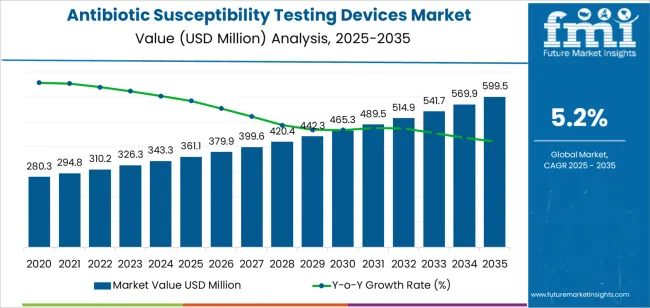
| Period | Primary Revenue Buckets | Share | Notes |
|---|---|---|---|
| Today | New device sales (AST devices, mass spectrometry systems) | 48% | Capex-led, laboratory capacity-driven purchases |
| Reagents & consumables | 28% | Culture media, test cartridges, quality controls | |
| Service & maintenance contracts | 16% | Preventive maintenance, calibration support | |
| Software & data management | 8% | Laboratory information systems integration | |
| Future (3-5 yrs) | Rapid identification systems | 42-47% | Point-of-care integration, molecular diagnostics |
| Reagents & consumables | 25-30% | Specialized media, molecular assays | |
| Service-as-a-subscription | 12-16% | Performance guarantees, outcome-based pricing | |
| Data & connectivity services | 8-12% | Antimicrobial stewardship programs, resistance surveillance | |
| Training & compliance services | 5-8% | Regulatory support, quality assurance programs | |
| Digital diagnostic platforms | 3-6% | Cloud-based analysis, AI-driven interpretation |
| Metric | Value |
|---|---|
| Market Value (2025) | USD 361.1 million |
| Market Forecast (2035) | USD 599.5 million |
| Growth Rate | 5.2% CAGR |
| Leading Technology | AST Devices |
| Primary Application | Hospital Segment |
The market demonstrates strong fundamentals with AST devices capturing a dominant share through advanced precision testing capabilities and diagnostic optimization. Hospital applications drive primary demand, supported by increasing antimicrobial resistance monitoring and pathogen identification requirements. Geographic expansion remains concentrated in developed markets with established diagnostic infrastructure, while emerging economies show accelerating adoption rates driven by healthcare modernization initiatives and rising quality standards.
Primary Classification: The market segments by diagnostic method into AST devices, nucleic acid detection devices, and mass spectrometry rapid identification devices, representing the evolution from conventional testing equipment to sophisticated diagnostic solutions for comprehensive antimicrobial resistance management.
Secondary Classification: Application segmentation divides the market into hospitals, third-party testing agencies, and other healthcare facilities, reflecting distinct requirements for diagnostic volume, operational efficiency, and testing accuracy standards.
Regional Classification: Geographic distribution covers North America, Latin America, Western Europe, Eastern Europe, East Asia, South Asia Pacific, and Middle East & Africa, with developed markets leading adoption while emerging economies show accelerating growth patterns driven by healthcare modernization expansion programs.
The segmentation structure reveals technology progression from standard testing equipment toward sophisticated diagnostic systems with enhanced precision and automation capabilities, while application diversity spans from hospital facilities to third-party testing operations requiring accurate antimicrobial susceptibility analysis solutions.
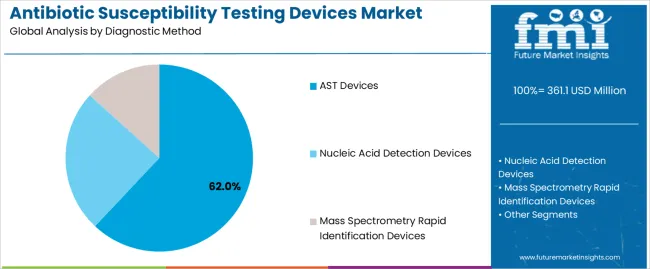
Market Position: AST Devices systems command the leading position in the antibiotic susceptibility testing devices market with 62% market share through advanced precision features, including superior testing accuracy, operational efficiency, and diagnostic optimization that enable laboratory facilities to achieve optimal pathogen identification consistency across diverse hospital and diagnostic environments.
Value Drivers: The segment benefits from laboratory facility preference for reliable testing systems that provide consistent diagnostic performance, reduced turnaround time, and operational efficiency optimization without requiring significant infrastructure modifications. Advanced design features enable automated quality control systems, result accuracy, and integration with existing laboratory equipment, where operational performance and regulatory compliance represent critical facility requirements.
Competitive Advantages: AST Devices systems differentiate through proven operational reliability, consistent testing characteristics, and integration with automated laboratory systems that enhance facility effectiveness while maintaining optimal quality standards suitable for diverse hospital and diagnostic applications.
Key market characteristics:
Nucleic Acid Detection Devices maintain a 24% market position in the antibiotic susceptibility testing devices market due to their rapid testing properties and molecular diagnostic advantages. These systems appeal to facilities requiring quick pathogen identification with competitive pricing for specialized diagnostic applications. Market growth is driven by laboratory expansion, emphasizing reliable molecular testing solutions and operational efficiency through optimized system designs.
Mass Spectrometry Rapid Identification Devices capture 14% market share through specialized testing requirements in reference laboratories, research facilities, and advanced diagnostic applications. These facilities demand comprehensive identification systems capable of handling diverse pathogens while providing effective analysis capabilities and operational precision.
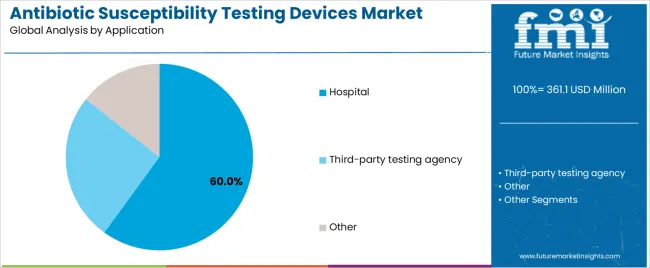
Market Context: Hospital applications demonstrate the highest market position in the antibiotic susceptibility testing devices market with 6.3% CAGR due to widespread adoption of diagnostic testing systems and increasing focus on antimicrobial stewardship optimization, infection control efficiency, and patient care applications that maximize treatment outcomes while maintaining quality standards.
Appeal Factors: Hospital operators prioritize system accuracy, diagnostic speed, and integration with existing laboratory infrastructure that enables coordinated testing operations across multiple departments. The segment benefits from substantial healthcare investment and modernization programs that emphasize the acquisition of advanced testing systems for infection control optimization and antimicrobial resistance management applications.
Growth Drivers: Healthcare expansion programs incorporate susceptibility testing devices as standard equipment for infectious disease management, while laboratory automation growth increases demand for rapid diagnostic capabilities that comply with quality standards and minimize operational complexity.
Market Challenges: Varying patient volumes and workflow complexity may limit system standardization across different facilities or diagnostic scenarios.
Application dynamics include:
Third-Party Testing Agency applications capture market share through specialized testing requirements in reference laboratories, diagnostic service providers, and contract testing operations. These facilities demand flexible diagnostic systems capable of operating with diverse specimen types while providing effective testing access and operational reliability capabilities.
Other applications account for market share, including research institutions, pharmaceutical companies, and veterinary diagnostic facilities requiring specialized testing capabilities for antimicrobial research and quality control applications.
| Category | Factor | Impact | Why It Matters |
|---|---|---|---|
| Driver | Rising antimicrobial resistance (AMR) & healthcare-associated infections | ★★★★★ | Global AMR crisis requires rapid, accurate testing for appropriate antibiotic selection; drives demand for advanced susceptibility testing across healthcare facilities. |
| Driver | Regulatory mandates & antimicrobial stewardship programs (CDC, WHO guidelines) | ★★★★★ | Turns advanced testing systems from "optional" to "mandatory"; vendors that provide compliance support and stewardship integration gain competitive advantage. |
| Driver | Point-of-care testing expansion & rapid diagnostic technologies | ★★★★☆ | Hospitals need faster turnaround times; demand for rapid identification and susceptibility testing expanding addressable market beyond central laboratories. |
| Restraint | High capital investment & maintenance costs (especially for mass spectrometry systems) | ★★★★☆ | Small hospitals and clinics defer purchases; increases price sensitivity and slows advanced equipment adoption in resource-limited settings. |
| Restraint | Technical expertise requirements & interpretation complexity | ★★★☆☆ | Smaller facilities face staffing challenges and training requirements, limiting operational capability and increasing dependency on external laboratory services. |
| Trend | Automation & artificial intelligence integration | ★★★★★ | Automated result interpretation, predictive susceptibility patterns, and machine learning enhance accuracy; AI-driven diagnostics become core value propositions. |
| Trend | Molecular diagnostics & genomic-based testing | ★★★★☆ | Rapid genetic testing for resistance markers; next-generation sequencing and PCR-based methods drive competition toward molecular diagnostic solutions. |
The antibiotic susceptibility testing devices market demonstrates varied regional dynamics with Growth Leaders including China (7% growth rate) and India (6.5% growth rate) driving expansion through healthcare modernization initiatives and diagnostic capacity development. Steady Performers encompass Germany (6% growth rate), Brazil (5.5% growth rate), and developed regions, benefiting from established healthcare systems and advanced diagnostic adoption. Emerging Markets feature United States (4.9% growth rate) and developed regions, where antimicrobial stewardship programs and resistance monitoring support consistent growth patterns.
Regional synthesis reveals East Asian markets leading adoption through healthcare expansion and diagnostic infrastructure development, while South Asian countries maintain rapid expansion supported by healthcare modernization and infection control requirements. North American markets show steady growth driven by antimicrobial stewardship applications and regulatory compliance trends.
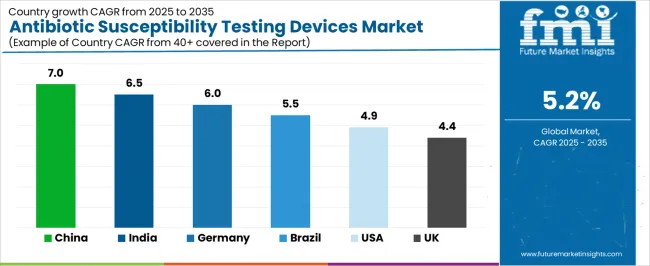
| Region/Country | 2025-2035 Growth | How to win | What to watch out |
|---|---|---|---|
| China | 7% | Lead with cost-effective automation | Localization requirements; price competition |
| India | 6.5% | Focus on affordable rapid testing | Infrastructure gaps; training needs |
| Germany | 6% | Offer premium molecular systems | Regulatory complexity; reimbursement policies |
| Brazil | 5.5% | Value-oriented diagnostic solutions | Currency fluctuations; import duties |
| USA | 4.9% | Provide stewardship integration | Market saturation; competitive pressure |
| UK | 4.4% | Push digital connectivity | NHS procurement cycles; budget constraints |
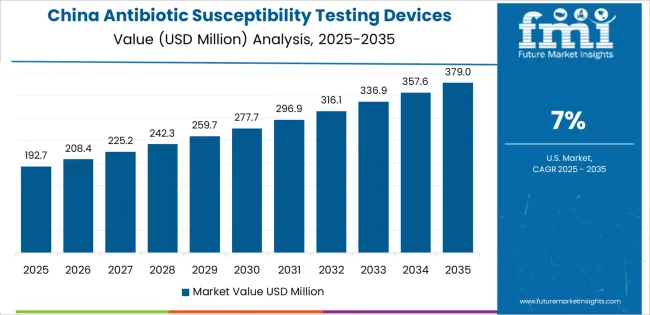
China establishes fastest market growth through aggressive healthcare modernization programs and comprehensive diagnostic capacity development, integrating advanced antibiotic susceptibility testing devices as standard components in hospital laboratories and reference testing installations. The country's 7% growth rate reflects government initiatives promoting antimicrobial resistance surveillance and healthcare quality improvement that mandate the use of advanced testing systems in hospital and diagnostic facilities. Growth concentrates in major metropolitan centers, including Beijing, Shanghai, and Guangzhou, where healthcare technology development showcases integrated testing systems that appeal to laboratory operators seeking advanced diagnostic optimization capabilities and quality management applications.
Chinese manufacturers are developing cost-effective testing solutions that combine domestic production advantages with advanced operational features, including automated analysis systems and enhanced accuracy capabilities. Distribution channels through medical equipment suppliers and healthcare service distributors expand market access, while government support for healthcare infrastructure supports adoption across diverse hospital and diagnostic segments.
Strategic Market Indicators:
In Delhi, Mumbai, and Bangalore, hospital facilities and diagnostic laboratories are implementing advanced antibiotic susceptibility testing devices as standard equipment for infection control and antimicrobial stewardship applications, driven by increasing government healthcare investment and laboratory modernization programs that emphasize the importance of accurate diagnostic capabilities. The market holds a 6.5% growth rate, supported by government healthcare initiatives and diagnostic infrastructure development programs that promote advanced testing systems for hospital and reference laboratory facilities. Indian operators are adopting testing systems that provide consistent operational performance and quality compliance features, particularly appealing in urban regions where diagnostic accuracy and turnaround time represent critical operational requirements.
Market expansion benefits from growing healthcare infrastructure capabilities and technology transfer agreements that enable domestic production of diagnostic testing systems for hospital and laboratory applications. Technology adoption follows patterns established in medical equipment, where reliability and accuracy drive procurement decisions and operational deployment.
Market Intelligence Brief:
Germany establishes technology leadership through comprehensive healthcare programs and advanced laboratory infrastructure development, integrating antibiotic susceptibility testing devices across hospital and diagnostic applications. The country's 6% growth rate reflects established healthcare system relationships and mature diagnostic technology adoption that supports widespread use of precision testing systems in hospital and reference laboratory facilities. Growth concentrates in major healthcare centers, including Baden-Württemberg, Bavaria, and North Rhine-Westphalia, where medical technology showcases advanced testing deployment that appeals to laboratory operators seeking proven diagnostic capabilities and operational efficiency applications.
German equipment providers leverage established distribution networks and comprehensive service capabilities, including validation programs and maintenance support that create customer relationships and operational advantages. The market benefits from mature regulatory standards and healthcare requirements that mandate testing system use while supporting technology advancement and operational optimization.
Market Intelligence Brief:
Brazil's market expansion benefits from diverse healthcare demand, including laboratory modernization in São Paulo and Rio de Janeiro, hospital facility upgrades, and government healthcare programs that increasingly incorporate testing solutions for infection control applications. The country maintains a 5.5% growth rate, driven by rising healthcare activity and increasing recognition of diagnostic testing benefits, including antimicrobial resistance monitoring and enhanced patient outcomes.
Market dynamics focus on cost-effective testing solutions that balance advanced operational performance with affordability considerations important to Brazilian healthcare operators. Growing healthcare industrialization creates continued demand for modern testing systems in new facility infrastructure and laboratory modernization projects.
Strategic Market Considerations:
United States establishes established market position through comprehensive antimicrobial stewardship programs and advanced laboratory infrastructure development, integrating antibiotic susceptibility testing devices across hospital and diagnostic applications. The country's 4.9% growth rate reflects mature healthcare system relationships and established testing technology adoption that supports widespread use of automated testing systems in hospital and reference laboratory facilities. Growth concentrates in major healthcare centers, including the Northeast, Midwest, and West Coast regions, where healthcare technology showcases mature testing deployment that appeals to laboratory operators seeking proven diagnostic capabilities and stewardship integration applications.
American equipment providers leverage established distribution networks and comprehensive service capabilities, including compliance support and data integration that create customer relationships and operational advantages. The market benefits from mature regulatory standards and stewardship requirements that mandate testing system use while supporting technology advancement and resistance surveillance.
Market Intelligence Brief:
United Kingdom's healthcare technology market demonstrates antibiotic susceptibility testing device deployment with documented operational effectiveness in NHS hospitals and diagnostic applications through integration with existing laboratory systems and healthcare infrastructure. The country leverages healthcare expertise in diagnostic technology and quality systems integration to maintain a 4.4% growth rate. Healthcare centers, including London, Manchester, and Birmingham, showcase installations where testing systems integrate with comprehensive laboratory platforms and facility management systems to optimize diagnostic operations and quality effectiveness.
British healthcare providers prioritize system accuracy and NHS compliance in testing equipment procurement, creating demand for reliable systems with advanced features, including facility monitoring integration and automated quality systems. The market benefits from established healthcare technology infrastructure and a commitment to invest in diagnostic technologies that provide operational benefits and compliance with national healthcare standards.
Market Intelligence Brief:

The European antibiotic susceptibility testing devices market is projected to grow from USD 123.6 million in 2025 to USD 190.2 million by 2035, registering a CAGR of 4.4% over the forecast period. Germany is expected to maintain its leadership position with a 28.6% market share in 2025, supported by its advanced laboratory infrastructure and comprehensive antimicrobial stewardship programs.
France follows with a 21.3% share in 2025, driven by healthcare modernization initiatives and infection control requirements. The United Kingdom holds a 19.7% share through established NHS laboratory networks and quality standards. Italy commands a 15.2% share, while Spain accounts for 11.8% in 2025. The rest of Europe region is anticipated to gain momentum, expanding its collective share from 3.4% to 4.6% by 2035, attributed to increasing diagnostic adoption in Nordic countries and emerging Eastern European healthcare facilities implementing laboratory modernization programs.

Japan demonstrates advanced technology integration in antibiotic susceptibility testing devices with comprehensive deployment across hospital laboratories and diagnostic facilities. The country maintains steady growth through healthcare quality emphasis and diagnostic precision requirements that support adoption of automated testing systems. Japanese healthcare facilities prioritize accuracy and reliability in diagnostic equipment procurement, creating consistent demand for premium testing solutions with advanced molecular capabilities. Market characteristics include high adoption rates in urban healthcare centers, established quality standards, and integration with comprehensive hospital information systems that optimize diagnostic workflows and antimicrobial stewardship programs.
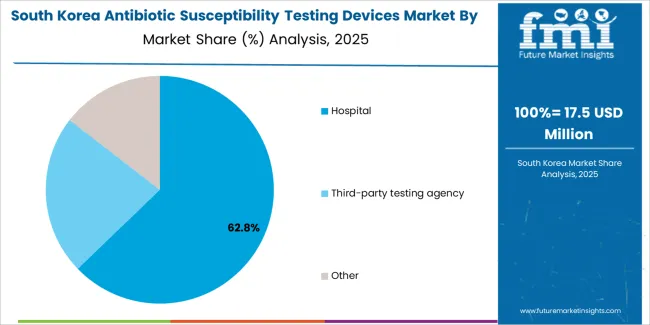
South Korea establishes healthcare innovation leadership through rapid adoption of advanced diagnostic technologies and comprehensive hospital modernization programs. The country leverages technology infrastructure and digital healthcare initiatives to support antibiotic susceptibility testing device deployment across major hospital networks and reference laboratories. Korean healthcare facilities emphasize rapid turnaround times and automated testing capabilities, driving demand for high-throughput systems with laboratory information system connectivity. Market growth benefits from government healthcare investment, technology-focused procurement standards, and increasing emphasis on antimicrobial resistance surveillance that position South Korea as a leading market for advanced diagnostic solutions.
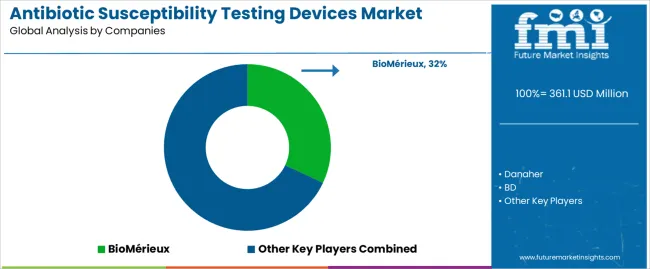
The antibiotic susceptibility testing devices market maintains a moderately consolidated structure with 12-18 credible players, where the top 4-5 companies hold approximately 68-73% market share by revenue. Leadership is maintained through comprehensive product portfolios spanning multiple testing methodologies, established laboratory relationships, and integrated service networks that provide validation support, reagent availability, and technical training programs. Market leaders differentiate through technological innovation combining rapid identification capabilities with automated susceptibility analysis, while also offering seamless integration with laboratory information systems and antimicrobial stewardship platforms.
Basic testing mechanisms and standard automated protocols are commoditizing, shifting competitive advantage toward value-added services including predictive analytics, resistance surveillance capabilities, and comprehensive compliance documentation. Margin opportunities concentrate in recurring revenue streams from reagents and consumables, service contracts with performance guarantees, and digital connectivity services that enable real-time result reporting and antimicrobial stewardship program integration. Companies investing in molecular diagnostic platforms and artificial intelligence-driven interpretation systems position themselves for premium market segments, while those focusing on cost-effective automation solutions capture growth in emerging markets and smaller healthcare facilities.
Strategic partnerships between device manufacturers and pharmaceutical companies create synergies in antimicrobial development and companion diagnostic applications. The competitive landscape reveals increasing emphasis on total laboratory solutions rather than standalone equipment, with successful players offering comprehensive portfolios that address diverse testing needs across hospital laboratories, reference facilities, and point-of-care applications. Technology convergence between traditional culture-based methods and molecular diagnostics creates opportunities for companies with integrated platforms, while regulatory compliance capabilities and quality assurance support remain fundamental requirements for market participation across developed healthcare systems.
| Stakeholder | What they actually control | Typical strengths | Typical blind spots |
|---|---|---|---|
| Global platforms | Distribution reach, comprehensive product lines, service networks | Broad availability, proven reliability, multi-region support | Technology refresh speed; emerging market pricing |
| Technology innovators | R&D capabilities; molecular diagnostics; AI integration | Latest features first; attractive accuracy and speed | Service density outside core regions; workflow complexity |
| Regional specialists | Local compliance, rapid delivery, nearby support | Close laboratory relationships; pragmatic pricing; local regulations | Technology gaps; talent retention in service |
| Service-focused ecosystems | Validation support, training programs, reagent supply | Lowest operational disruption; comprehensive support | Service costs if overpromised; technology obsolescence |
| Niche specialists | Specialized applications, research solutions, veterinary diagnostics | Win research and specialized applications; flexible configurations | Scalability limitations; narrow market focus |
| Item | Value |
|---|---|
| Quantitative Units | USD 361.1 million |
| Diagnostic Method | AST Devices, Nucleic Acid Detection Devices, Mass Spectrometry Rapid Identification Devices |
| Application | Hospital, Third-party testing agency, Other |
| Regions Covered | North America, Latin America, Western Europe, Eastern Europe, East Asia, South Asia Pacific, Middle East & Africa |
| Countries Covered | United States, China, Germany, India, United Kingdom, Japan, Brazil, France, South Korea, Canada, and 25+ additional countries |
| Key Companies Profiled | BioMérieux, Danaher, BD, Thermo Fisher Scientific, Deere, Meihua, Xinke, Roche |
| Additional Attributes | Dollar sales by diagnostic method and application categories, regional adoption trends across East Asia, South Asia Pacific, and North America, competitive landscape with diagnostic equipment manufacturers and laboratory service providers, healthcare facility preferences for testing accuracy and system reliability, integration with laboratory information systems and antimicrobial stewardship platforms, innovations in rapid identification technology and molecular diagnostics, and development of automated testing solutions with enhanced performance and diagnostic optimization capabilities. |
The global antibiotic susceptibility testing devices market is estimated to be valued at USD 361.1 million in 2025.
The market size for the antibiotic susceptibility testing devices market is projected to reach USD 599.5 million by 2035.
The antibiotic susceptibility testing devices market is expected to grow at a 5.2% CAGR between 2025 and 2035.
The key product types in antibiotic susceptibility testing devices market are ast devices, nucleic acid detection devices and mass spectrometry rapid identification devices.
In terms of application, hospital segment to command 60.0% share in the antibiotic susceptibility testing devices market in 2025.






Full Research Suite comprises of:
Market outlook & trends analysis
Interviews & case studies
Strategic recommendations
Vendor profiles & capabilities analysis
5-year forecasts
8 regions and 60+ country-level data splits
Market segment data splits
12 months of continuous data updates
DELIVERED AS:
PDF EXCEL ONLINE
Antibiotics Active Pharmaceutical Ingredient (API) Market - Growth & Forecast 2025 to 2035
Global Antibiotic-Resistant Infections Treatment Market Analysis – Size, Share & Forecast 2024-2034
Global Antibiotic Drug Market Analysis – Size, Share & Forecast 2023-2033
Antibiotic Resistance Diagnosis Devices Market Size and Share Forecast Outlook 2025 to 2035
Antibiotic Resistance Testing and Diagnostic Devices Market Size and Share Forecast Outlook 2025 to 2035
Animal Antibiotics and Antimicrobials Market Size and Share Forecast Outlook 2025 to 2035
Topical Antibiotic Pharmaceuticals Market Size and Share Forecast Outlook 2025 to 2035
Peptide Antibiotics Market
Veterinary Antibiotics Market Size and Share Forecast Outlook 2025 to 2035
Animal Feed Antibiotics Market - Size, Share, and Forecast Outlook 2025 to 2035
Intracameral Antibiotics Market Analysis - Size, Share, and Forecast Outlook 2025 to 2035
Probiotics After Antibiotic Recovery Market Analysis by Ingredient and Sales Channel Through 2035
Animal Antimicrobials and Antibiotics Market Size and Share Forecast Outlook 2025 to 2035
Antimicrobial Susceptibility Tester Market Size and Share Forecast Outlook 2025 to 2035
Antimicrobial Susceptibility Testing Market Growth – Industry Forecast 2025-2035
FBAR Devices Market
Snare devices Market
C-Arms Devices Market Size and Share Forecast Outlook 2025 to 2035
Timing Devices Market Analysis - Size, Growth, & Forecast Outlook 2025 to 2035
Spinal Devices Market Size and Share Forecast Outlook 2025 to 2035

Thank you!
You will receive an email from our Business Development Manager. Please be sure to check your SPAM/JUNK folder too.
Chat With
MaRIA